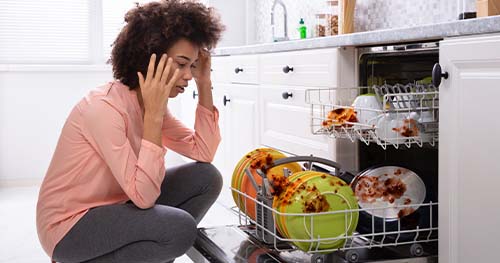Dishwashers are fantastic appliances that can save you a lot of time and stress. But not all dishwashers are created equal. While they can provide many years of dependable service if they are correctly maintained, there is always a risk that your appliance might need repair.
But the good news is that dishwashers are actually straightforward devices. So, it’s easy to troubleshoot common dishwasher problems yourself.
Dishes Aren’t Coming Out Clean
Dishwashers will sometimes not clean properly, even when everything is fine with the rinse aid or the detergent. If your dishwasher is not cleaning dishes, try these troubleshooting tips:
- Check the filter and rinse aid dispenser. Dirty filters restrict water flow and can cause dishes to come out dirty. Check for any debris in these parts and clean them as needed.
- Look for leaks. A leaky door seal or gasket can cause water to pool inside the machine and create a moldy smell. Make sure all seals are intact and replaced if necessary.
- Run a cycle without any dishes or food in the machine. If this works, you may have an issue with the dishwasher’s internal components that only show up when there are no dishes inside to soak up some excess water from the jets or spray arms.
Check your dishwasher manual for additional troubleshooting tips if this doesn’t work. Or call your local plumber for a professional opinion.
Dishwasher Doesn’t Run
If your dishwasher isn’t running at all, there could be a problem with the power source. First, ensure power is getting to your dishwasher by turning off breakers or flipping switches in your home’s electrical panel. If there is no power, check for tripped circuit breakers or blown fuses in circuit panels.


Dishwasher Doesn’t Fill
If your dishwasher isn’t filling with water, it might be because something is blocking its water intake valve, such as a piece of food or other debris. First, check the area around the valve to see if anything is stuck there, then pull out any obstruction by hand. If this doesn’t work, use pliers or wire cutters to cut away whatever is blocking the valve so it can open fully.

Dishwasher Doesn’t Drain
Dishwashers are designed to drain water from the bottom of the unit, but if your dishwasher isn’t draining properly, it can be a real headache. You don’t want dishes lying in dirty water.

Dishwasher Smells Bad
The most common reason for a foul odor in your dishwasher is mold or mildew buildup inside the tub. To determine if this is the problem, first open the door and check for signs of mold or mildew on the rubber seal around the door opening.

Struggling with a broken dishwasher? Call the plumbing professionals at Adeedo and get your dishes sparkling again.

